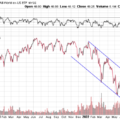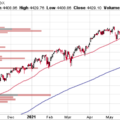In a Nutshell: After a big pop and drop in the first few months of the year, stocks, bonds, and commodities have reverted back to where they started the year. Stocks look like they need a break, while interest rates continue higher.
Domestic Equity: No Man’s Land
The U.S. stock market is sitting in a precarious position to close out February. The economic data saw a short-term jolt higher within a longer-term slowing trend. The price action of the S&P 500 is stuck in the middle of an area of confluence. The market is below a failed breakout area, while staying slightly above the downtrend channel from 2022 – and this while trading right at the short term uptrend line and series of additional support levels. It’s quite possible the market participants lack consensus as to where the market should head next. At this point in time there is plenty for the bears and the bulls. The challenge from here is we could easily trade sideways from 3800 to 4100 and we still wouldn’t have a lot more sense of direction from a price perspective.
Looking under the surface, our participation indicator shows that we’re back to neutral territory, albeit coming from the first positive print in about a year. We posited that the next price pullback would need to stay out of the negative area from a participation standpoint, which has happened as of now.
Our sentiment indicator gives us more of the same with another neutral reading. Although it’s worth noting sentiment was lower on the January high mark when compared to the November high mark. When you balance price, participation, sentiment and economic data, the market appears uncertain and content, for now, to wait for more information.
The Federal Reserve raised interest rates 0.25% to start February off, marking a reduction in the pace of interest rate increases, yet increasing nonetheless. The Fed remains resolute in raising rates to combat inflation, even at the risk of recession. Part of the contributing factor to current market confusion is that the inflation numbers from the past few months that looked good were revised to show that inflation is not going down as fast as hoped. This revised inflation data, and subsequent Fed commentary, has driven rate expectations much higher. We entered the year with expectations of 0.5% of total increases spread across February and March before stopping for the year, with a terminal rate around 5%. Currently the bond market has a 1% increase in 2023 split over February, March and May with a terminal rate in the 5.5-5.75% range. This is a huge change to forward-looking rates, and likely a big reason why the stock market rally is on pause.
Global Equity: The Best of the Bunch
Global equities pulled back like all risk assets in February, but were able to hold key support so far – something no other sector can say. This rare display of relative strength gives us optimism for the sector. For the better part of the last two years, global equities have lagged all risk assets. As long as support (blue horizontal line) is held, we will continue to build out our global equity position. The fly in the ointment for this sector is the fact that China, which has led this global rally, has been trading with much weaker price action when compared to the broader index. If China is not leading this group, we’d have concerns about the sustainability of the rally from here.
Real Estate: Headfake
Real estate got off to a great start to the year, but has since cooled off and is now in a neutral-to-weak position. Risk assets in general needed to cool off following the hot start to the year, which they did. Unfortunately for real estate, that came with the double whammy of interest rates ripping higher, setting new recent highs for the 30-year mortgage rate – even hitting 7.1% recently and putting enormous pressure on real estate prices. This setup has real estate in a tough spot, from a price perspective. It’s currently stuck between the short-term and medium-term trends, not really confirming either direction. We’ll continue to monitor this sector, but will need more data and evidence to hold a position here.
Commodities: Slow Motion Break Down
The commodities sector appears to have finally broken the downside support that had propped it up for the last six months, but has struggled to move significantly lower. Even more impressive is the way it was done. This highly volatile sector has spent the last six years trading in a tighter and tighter range compressed within a 10% window. While price is below support, the lack of movement lower while compressing is starting to raise the possibility of a break higher, which would be good for commodities but bad for inflation.
Gold had a good news, bad news type of month in February. We stated gold would be facing two headwinds last month and those showed up in spades, unfortunately pushing gold back down to even for the year. The good news is that gold found its footing right where we would hope it would – at the horizontal blue line. With interest rates now temporarily stretched to the upside, gold may have the wind at its back for a bit.
Fixed Income: Interest Rates Rally Again
We noted last month that the ten-year U.S. treasury yield got close to breaking 3.5%, but failed to do it. The result was another wild rally as rates rallied by more than 14% up to 4% nominally. Where rates go from here will be quite telling. If we had to guess, this might be the last hurrah for longer-term rates as we look like we may be in a topping formation now after the broader uptrend broke.
From a timing perspective, that would fit with our extremely inverted yield curve. Inversions tend to precede recessions, and in recessions long-term rates tend to fall significantly as future growth expectations fall. This is what history suggests when yield curves become inverted, so while this time may be different, we do have some precedence for recession following inversion. The last inflation-induced recession was the double-dip recession from 1979 to 1982. Our yield curve is now at the most inverted reading since 1981.
We reiterate that interest rates will be the key in 2023, and something we’ll continue to monitor to assess all risk assets this year.
All Terrain Portfolio Update
While we have reduced our risk coming into March, we continue to hold small positions in defensive stocks, precious metals and positions in global equity. The vast majority of the model remains in risk averse, short-term treasuries and notes that are paying interest in the 4.7% to 5.5% range. Our data and outlook continue to be weak for the first half of 2023, so we will remain risk averse and agile until the data improves. We will continue to wait for investment opportunities and, in the meantime, follow our indicators and process to adjust risk as new data is presented.
Past performance is not indicative of future results. Other asset classes or investment vehicles may be used in client portfolios and client portfolios may not hold all positions of the model at the same time as the model. This chart and its representations are only for use in correlation to the proprietary timing model by Arkenstone Financial, Registered Investment Advisor. Actual client and All Terrain Portfolio(TM) positions may differ from this representation.
- U.S. Stocks Make New Highs - December 6, 2024
- Rising Rates Create Headwinds - November 8, 2024
- The Fed Finally Cuts Rates - October 10, 2024



Leave a Reply